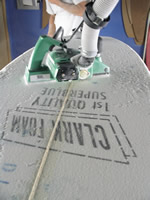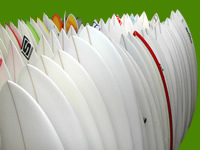Anatomy of a Polyurethane/Polyester Board
In the next few months we will be exploring the most common surfboard construction methods as a primer to open a broader discussion regarding sustainability. We will include some links for further reading as any written work on surfboard building materials can fill pages and pages of information depending on how deep one wishes to delve into the subject.
POLYURETHANE CORE AND POLYESTER RESIN CONSTRUCTION
The most common type of material used since the late 1950’s, polyurethane is a petroleum-based product used in many industries like surfing and boat building. The foam core is easy to shape and has low water absorption qualities. Clark Foam was the leading producer of urethane foam blanks for the last few decades, producing over 90% of all surfboard blanks used in the United States.  Urethane blanks can be hand or machine shaped and generally come close tolerance (shape and rocker can be custom ordered), requiring minimal shaping. Once the blank is shaped it is covered in layers of fiberglass cloth and glassed with polyester resin.
Urethane blanks can be hand or machine shaped and generally come close tolerance (shape and rocker can be custom ordered), requiring minimal shaping. Once the blank is shaped it is covered in layers of fiberglass cloth and glassed with polyester resin.
Urethane is the most common and cheapest form of construction for commercial handmade surfboards at this time. There are many tools and supplies available around this platform, making it a popular approach. In addition, the responsiveness and “feel” of polyester is the benchmark for other building materials. Polyester contains highly noxious chemicals such as 2,4-Toluene diisocyanate. It is neither biodegradable nor recyclable and working with it can cause respiratory problems and other health hazards. Being petroleum based, it is destined to become scarce and increasingly expensive.
It must be pointed out however that there are ways of making durable urethane boards. Many of the boards seen in surf shops are super light high-performance boards like the ones used by professional surfers. As in other competitive sports like cycling, light equipment provides a competitive advantage. Often longevity of the equipment is not a concern to the average competitive surfer. However, since most surfers are not competitive, nor able to take full advantage of the light equipment the way a pro would, the benefit of ultra light is often outweighed by its respective decrease in life spans.
A standard shortboard today is made using a light blank and glassed with two layers of 4 oz. glass on the deck and layer of 4 oz. glass on the bottom. This type of board will generally last less than a year under normal use.
A urethane board can be made using denser blanks and heavier glass. The same high performance shortboard can be made using a stronger blank and glassed with 6 oz. glass instead of 4 oz. resulting in a board that, although a little heavier will perform about the same and outlast its lighter counterpart under normal use.
Most shops don’t disclose what type of glass job an off-the-rack board has, and many times shop employees may not even have that information available to them. This is where customer education comes into play.  The consumer must have the knowledge to ask what glass schedule a board uses, or request their preferred glass job on a custom board. Often shapers will default to a 6/4/4 or a 4/4/4 glass job which, for the average surfer is going to be much less durable, more prone to heel dents and dings, than the same board with a 6/6/6 glass job (6/6/6 meaning – 6oz.deck/6oz. deck/6oz. bottom, 6/4/4 would be 6oz. deck/4 oz. deck/4oz. bottom). The weight difference is neglible compared to the added lifespan and durability that the heavier glass job offers. It all goes back to the consumer being educated about the process and demanding, by their spending habits, that manufacturers create more durable boards, no matter what process they are using to achieve that. A stronger, more durable polyester board can easily be made; it’s just up to the consumer to request it.
The consumer must have the knowledge to ask what glass schedule a board uses, or request their preferred glass job on a custom board. Often shapers will default to a 6/4/4 or a 4/4/4 glass job which, for the average surfer is going to be much less durable, more prone to heel dents and dings, than the same board with a 6/6/6 glass job (6/6/6 meaning – 6oz.deck/6oz. deck/6oz. bottom, 6/4/4 would be 6oz. deck/4 oz. deck/4oz. bottom). The weight difference is neglible compared to the added lifespan and durability that the heavier glass job offers. It all goes back to the consumer being educated about the process and demanding, by their spending habits, that manufacturers create more durable boards, no matter what process they are using to achieve that. A stronger, more durable polyester board can easily be made; it’s just up to the consumer to request it.
As a disclaimer, this info is a VERY general overview of the materials used on the average Polyurethane/Polyester board. There are so many variables in blanks, glass weights and types (e-glass, s-class, etc.) and different resin formulations, that there are an astounding number of possible variations. Basically, what we are trying to get across with this information is that next time you are purchasing a board ask questions. What type of blank does the board use, what type of glass job does it have? If the shop doesn’t have the answers to these questions ask them why? You’re about to spend your hard earned money on a piece of performance sporting equipment and you deserve to know what type of longevity to expect out of it. These are all key factors in the durability and performance of your board.
Reference and Additional Reading: 
Breaking Point by Brad Melekian in Surfer Magazine